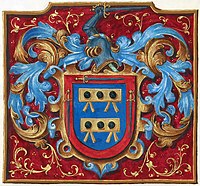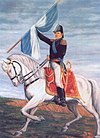Welcome to the Heraldry and Vexillology Portal!


Heraldry encompasses all of the duties of a herald, including the science and art of designing, displaying, describing and recording coats of arms and badges, as well as the formal ceremonies and laws that regulate the use and inheritance of arms. The origins of heraldry lie in the medieval need to distinguish participants in battles or jousts, whose faces were hidden by steel helmets.
Vexillology (from the Latin vexillum, a flag or banner) is the scholarly study of flags, including the creation and development of a body of knowledge about flags of all types, their forms and functions, and of scientific theories and principles based on that knowledge. Flags were originally used to assist military coordination on the battlefield, and have evolved into a general tool for signalling and identification, particularly identification of countries.
Selected biography
Sir Alexander Colin Cole, KCB, KCVO, (16 May 1922–20 February 2001) was a long serving officer of arms at the College of Arms in London. He eventually rose to the rank of Garter Principal King of Arms, the highest heraldic office in England. Prior to his joining the College of Arms he represented the Manchester Palace of Varieties in the Court of Chivalry for the only case it has tried in the last 200 years. He designed the coat of arms for Margaret Thatcher. (more...)
Selected coat of arms

The coat of arms of Albany, New York is a heraldic symbol representing the city of Albany, the capital of the U.S. state of New York. The coat of arms is rarely seen by itself; it is almost always used in the city seal or on the city flag. The current coat of arms was adopted in 1789, although prior to that it was significantly simpler, ranging from stylized lettering to a caricature of a beaver. Included in the coat of arms are references to Albany's agricultural and fur-trading past. It is supported by a white man and an American Indian and is crested by a sloop. The coat of arms is meant to represent the "symbols of industry and its rewards to man and beast on land and sea". (more...)
Selected flag

The national flag of Armenia, the Armenian Tricolor, consists of three horizontal bands of equal width, red on the top, blue in the middle, and orange on the bottom. The Armenian Supreme Council adopted the current flag on August 24, 1990. On June 15, 2006, the Law on the National Flag of Armenia was passed by the Armenian Parliament.
Throughout history, there were many variations of the Armenian flag. In ancient times, Armenian Dynasties were represented by different symbolic animals displayed on their flags. In the 20th century, there were several Soviet flags representing Armenian nation. (more...)
Selected picture
Illustration from a manuscript grant of arms by Philip II of Spain to Alonso de Mesa and Hernando de Mesa, signed 25 November 1566. Digitally restored.
Did you know...
- ...that the Flag of Macha (pictured) is considered to be the first physical flag of Argentina?
- ...that Indonesia's first flag flown was fashioned by its first first lady Fatmawati?
- ...that Albany, New York has a life-size version of its coat of arms that was sculpted by a local political cartoonist?
- ...that the Duke of Cambridge's Personal Canadian Flag was first used during the 2011 royal tour of Canada?
- ...that Hinke Bergegren's Under röd flagg was the first periodical to introduce detailed accounts of anarchist thought in Sweden?
Related portals
|
|
|
Heraldry Web resources
Authorities
- Belgium - The Council of Nobility, Flemish Heraldic Council and Council of Heraldry and Vexillology of the French Community
- Canada - Canadian Heraldic Authority and see also Public Register of Arms, Flags and Badges
- England, Wales, and Northern Ireland - The College of Arms
- Ireland - The Office of the Chief Herald of Ireland
- Netherlands - High Council of Nobility
- Portugal - Instituto da Nobreza Portuguesa
- Scotland - The Court of the Lord Lyon
- South Africa - South African Bureau of Heraldry
- Sweden - National Board of Heraldry, The National Archive
- United States Army - The United States Army Institute of Heraldry
Societies
- Greek Heraldry Society
- The Academy of Heraldic Science Czech republic
- The American College of Heraldry
- The American Heraldry Society
- The Augustan Society
- The Australian Heraldry Society Inc.
- Bulgarian Heraldry and Vexillology Society
- The Center for Research of Orthodox Monarchism
- Cambridge University Heraldic and Genealogical Society
- Chiltern Heraldry Group
- The College of Dracology
- Croatian Heraldic and Vexillologic Association
- The Finnish Heraldic Society
- Fryske Rie foar Heraldyk
- Hellenic Armigers Society
- Guild of Heraldic Artists
- Genealogical Society of Ireland
- Heraldry Research Institute (Japan)
- The Heraldry Society
- The Heraldry Society of Africa
- The Heraldry Society of New Zealand Inc.
- The Heraldry Society of Scotland
- The Heraldry Society of Southern Africa
- The Institute of Heraldic and Genealogical Studies
- The International Association of Amateur Heralds
- Italian Center of Vexillological Studies
- Lancashire Heraldry Group
- Macedonian Heraldry Society
- New England Historic Genealogical Society Committee on Heraldry
- Norwegian Heraldry Society
- Oxford University Heraldry Society
- Polish Heraldry Society
- Polish Nobility Confederation
- Real Academia Matritense de Heráldica y Genealogía - Royal Academy of Heraldry and Genealogy of Madrid
- Romanian Institute for Genealogy and Heraldry
- The Royal Heraldry Society of Canada
- The Russian College of HeraldryThe Russian College of Heraldry
- Serbian Heraldic Society
- Societas Heraldica Scandinavica
- Societas Heraldica Slovenica
- Swedish Heraldic Society
- Ukrainian Heraldry Society
- Royal Association Genealogical and Heraldic Office of Belgium
Vexillology
Software
- Coat of Arms Visual Designer web-based program
- Puncher Heraldry Program
- Blazonry Server - pyBlazon
- DrawShield - creates SVG shield or arms image from blazon
- CoaMaker - web-based tool
- Blazon95 and BLAZONS! 2000, older Windows applications
Texts
- Heraldry, historical and popular : with seven hundred illustrations (1863)
- A Complete Guide to Heraldry (1909)
Other
Wikimedia
The following Wikimedia Foundation sister projects provide more on this subject:
-
Commons
Free media repository -
Wikibooks
Free textbooks and manuals -
Wikidata
Free knowledge base -
Wikinews
Free-content news -
Wikiquote
Collection of quotations -
Wikisource
Free-content library -
Wikispecies
Directory of species -
Wikiversity
Free learning tools -
Wikivoyage
Free travel guide -
Wiktionary
Dictionary and thesaurus












